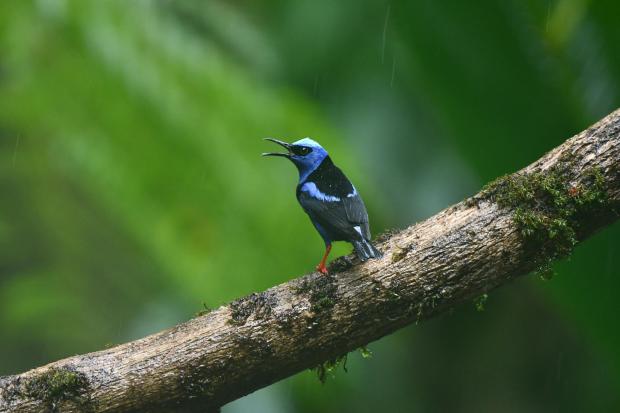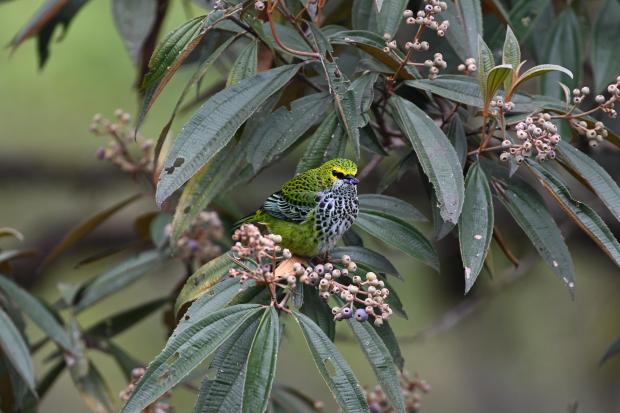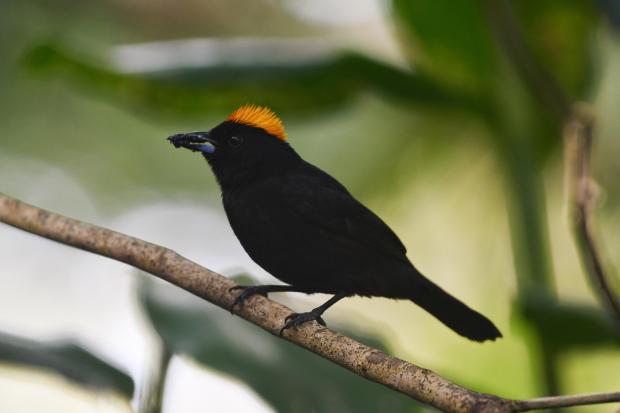tanager top ten
We were roadtripping through California, on home leave after our first overseas posting to Nairobi, when we caught sight of our very first tanager. A splash of bright color, a flutter of wings, and the bird settled high in a pine tree. Our assignment to Kenya had sparked D’s interest in birding, but we were still complete neophytes back then. There are no tanagers in Africa. That splash of color proved a preview to the joys that awaited us when set out to bird the American tropics.

At the time, we had no idea what the bird was and only identified it as a Western tanager thanks to the terrible photo D managed. Previously lumped with its neotropical cousins, this bird is no longer considered to be a true tanager, which are few in the northern latitudes. To see true tanagers, we had to wait a decade to be assigned to Costa Rica, which boasts nearly fifty such species. We’ve been delighting in their fancifully patterned plumage over the last two-plus years.

Several of Costa Rica’s most striking tanagers are also among the country’s most common birds, rendering birdwatching a delightful experience even for those who aren’t particularly drawn to this hobby. Scarlet-rumped tanagers, in particular, are ubiquitous, their flame-colored rumps contrasting brilliantly against their jet-black plumage. Another fan favorite with a bright-red rump is the crimson-collared tanager, pictured above. Its blood-red feathers are so striking that the bird is known locally as sangre del toro (“bull’s blood”).

Whittling down our Top Ten Tanager list for Costa Rica, which was D’s intention when he sat down to pen this post, is no easy matter. In addition to the true tanagers, there are another twenty species that were previously considered to belong to the same family and have since been split off. Most, like the Western tanager — which makes infrequent visits this far south — are now grouped into the cardinal family. Accounting for both the true tanagers and their allies, there are seventy species to choose from.

Some, like the red-legged honeycreeper pictured above, are small and far from shy. Others, like the blue-and-gold tanager, are striking but are also near threatened and infrequently seen. D has glimpsed the latter species only a couple of times, hanging out on the periphery of large flocks deep inside the forest. The handful of pictures he has managed are barely good enough for identification purposes and most assuredly are not fit to print.

There are half-a-dozen species, including one endemic to the Cocos island, D still has never laid eyes on. Several others, we’ve seen various times but failed to photograph well. The spangle-cheeked tanager is among these, as is the shining honeycreeper — perhaps the most striking of the three honeycreepers that grace the Costa Rican canopy.

Photo quality was an important factor in determining our top ten — posting middling photos of these incredibly colorful birds simply wouldn’t do them justice, which is why we left out the shining honeycreeper while including the green and red-legged varieties. Uniqueness also played a role in our selection. For example, the black-and-yellow tanager lacks the kaleidoscope of colors of other tanagers but is a favorite with local birders and birding guides, including D’s birding buddy.

After some back-and-forth, D also decided to confine this post to true tanager species only. This leaves out the near endemic black-cheeked ant-tanager, a near threatened bird we glimpsed once in Osa. This bird has an incredibly limited range in the southern corner of Costa Rica but there are also occasional reports of black-cheeked ant-tanagers just across the Panama border, rendering it not a true endemic. Constraining the list to true tanagers only also excludes the flame-colored tanager, a stunner of a bird in the cardinal family that earns an honorable mention for its brilliant plumage. We couldn’t resist, and included a picture at the very end of the post.

While many tanager species readily flock to gardens and feeders, some are reliably seen only inside forest interiors. In their proper habitat, however, they are quite common. Among these, the tawny-crested tanager, with its punk-rock mohawk, is a particular favorite — and not just for us. D had gotten somewhat inured to seeing large flocks of tawny-crested tanagers in Braulio Carrillo National Park until he birded with a Tico friend who now lives in the United States. The palpable joy this friend experienced seeing this fairly common forest species jolted D and caused him to rethink how he approaches birding.

Because so many of these incredible birds are also incredibly common, it is easy to stop paying attention to them after a while. Birding with his friend and seeing his joy reminded D not to take these common sightings for granted. After all, when we started on this birding journey, we didn’t even know what a tanager was. Soon we’ll leave Costa Rica, and while our next posting in Ecuador promises to offer many more opportunities to see these and other tanager species, we have no idea where life might take us from there.

Pictured from above, top to bottom: silver-throated tanager; crimson-collared tanager; golden-hooded tanager; red-legged honeycreeper; speckled tanager; green honeycreeper; black-and-yellow tanager; bay-headed tanager; tawny-crested tanager; emerald tanager; and flame-colored tanager below.

